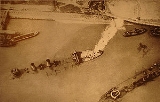
Zeebrugge Raid
Overview
United Kingdom of Great Britain and Ireland
The United Kingdom of Great Britain and Ireland was the formal name of the United Kingdom during the period when what is now the Republic of Ireland formed a part of it....
Royal Navy
Royal Navy
The Royal Navy is the naval warfare service branch of the British Armed Forces. Founded in the 16th century, it is the oldest service branch and is known as the Senior Service...
to neutralize the key Belgian
Belgium
Belgium , officially the Kingdom of Belgium, is a federal state in Western Europe. It is a founding member of the European Union and hosts the EU's headquarters, and those of several other major international organisations such as NATO.Belgium is also a member of, or affiliated to, many...
port of Bruges-Zeebrugge. The port was used by the German Navy
German Navy
The German Navy is the navy of Germany and is part of the unified Bundeswehr .The German Navy traces its roots back to the Imperial Fleet of the revolutionary era of 1848 – 52 and more directly to the Prussian Navy, which later evolved into the Northern German Federal Navy...
as a base for their U-boats and light shipping, which was a serious threat to Allied
Allies of World War I
The Entente Powers were the countries at war with the Central Powers during World War I. The members of the Triple Entente were the United Kingdom, France, and the Russian Empire; Italy entered the war on their side in 1915...
shipping, especially in the English Channel
English Channel
The English Channel , often referred to simply as the Channel, is an arm of the Atlantic Ocean that separates southern England from northern France, and joins the North Sea to the Atlantic. It is about long and varies in width from at its widest to in the Strait of Dover...
.
A raid on Zeebrugge was first proposed in 1917 by Sir John Jellicoe
John Jellicoe, 1st Earl Jellicoe
Admiral of the Fleet John Rushworth Jellicoe, 1st Earl Jellicoe, GCB, OM, GCVO was a British Royal Navy admiral who commanded the Grand Fleet at the Battle of Jutland in World War I...
, but was not authorised until Vice-Admiral Sir Roger Keyes
Roger John Brownlow Keyes, 1st Baron Keyes
Admiral of the Fleet Roger John Brownlow Keyes, 1st Baron Keyes, Bt GCB KCVO CMG DSO RN was a noted British admiral, with an active service life that included 19th-century African anti-slavery patrols to the Allied landings in Leyte in World War II...
created a plan for a blocking operation
Blockship
A blockship is a ship deliberately sunk to prevent a river, channel, or canal from being used.It may either be sunk by a navy defending the waterway to prevent the ingress of attacking enemy forces, as in the case of HMS Hood at Portland Harbour; or it may be brought by enemy raiders and used to...
which would make it difficult for German ships and submarine
Submarine
A submarine is a watercraft capable of independent operation below the surface of the water. It differs from a submersible, which has more limited underwater capability...
s to leave the port.

